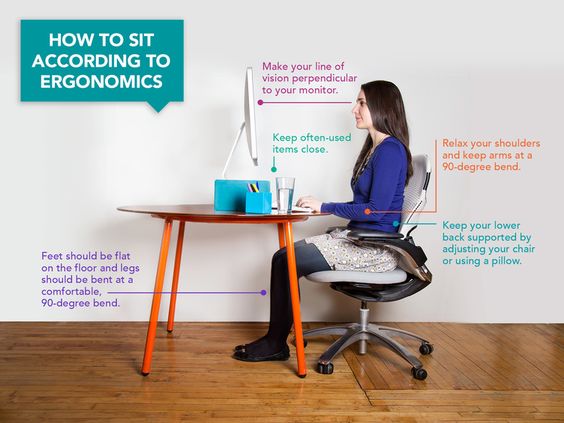We all know that sitting for long periods of time is bad for your health, but how you sit is just as important.
While both standing and treadmill desks are becoming trendy, they haven’t become the office norm quite yet.
Here are some tips and tricks on how to sit pretty at your desk for long periods of time. But of course, it’s always good to take a break and stroll to get some coffee or go chat with a co-worker to keep your blood flowing.
1. Computer Monitor and Eyes
Looking down at your computer screen puts extra strain on your neck, which can leave you vulnerable to injuries such as cervical disc herniation and strains along with headaches. Keep your eyes in line with the area of the screen you focus on the most. If you’re sending a lot of emails, you’ll be looking more at the top of the screen. If you’re writing a bunch of code, the bottom of the screen. Stacking books is a quick and simple trick to raise your screen to eye level. If you happen to be a multi-monitor worker, be sure to apply this tip to the monitor you use the most.
2. Desk
Anything you constantly use — such as your phone, mouse, or water bottle — can be an added stressor on your body if you’re always reaching out to grab it. It’s a good rule of thumb to keep these items within a foot of reach to keep added stressors at bay.
3. Arms
When your arms are stretched and extended, your shoulders actually start to rotate forward, causing you to lose strength in your upper back. To avoid shoulder injuries and chronic upper back pain, keep your arms at a comfortable 90-degree angle in a nice, neutral resting position. Use those armrests to lend you a helping hand!
4. Back
You want your back to be comfortable and supported, with a small curve in the lumbar spine where your natural lower back is. Without support, the back tends to get too much curve in the opposite direction — what’s known as kyphosis, or commonly, hunchback — leaving the lower back perfectly exposed to disc herniation and chronic postural lower back sprains and strains. If you don’t have a chair that can provide support, getting creative with pillows and jackets will help you out.
5. Legs and Feet
When your legs are crossed or just your toes are touching the floor, you’re putting unnecessary stress on large supportive muscles in your legs and hampering proper blood flow. Even little things — like keeping your legs crossed all day long — can lead to chronic pain. It is of course okay to cross your legs every once in a while, but it’s important to be aware of your body position.
6. Vertical Alignment
While seated, you never want to be reaching or leaning forward. For every inch that your head comes forward, the spine feels like it has taken on an extra 10 pounds, bringing on some major strain for your muscles. Start becoming aware of how you’re sitting. Are you leaning forward too much? Are you hunched over your computer screen? Put a sticky note on the bottom of your monitor to remind you to be mindful of what your spine is doing.
What do you do to help ease the stress of sitting at your computer all day? Share your tips in the comments below!

